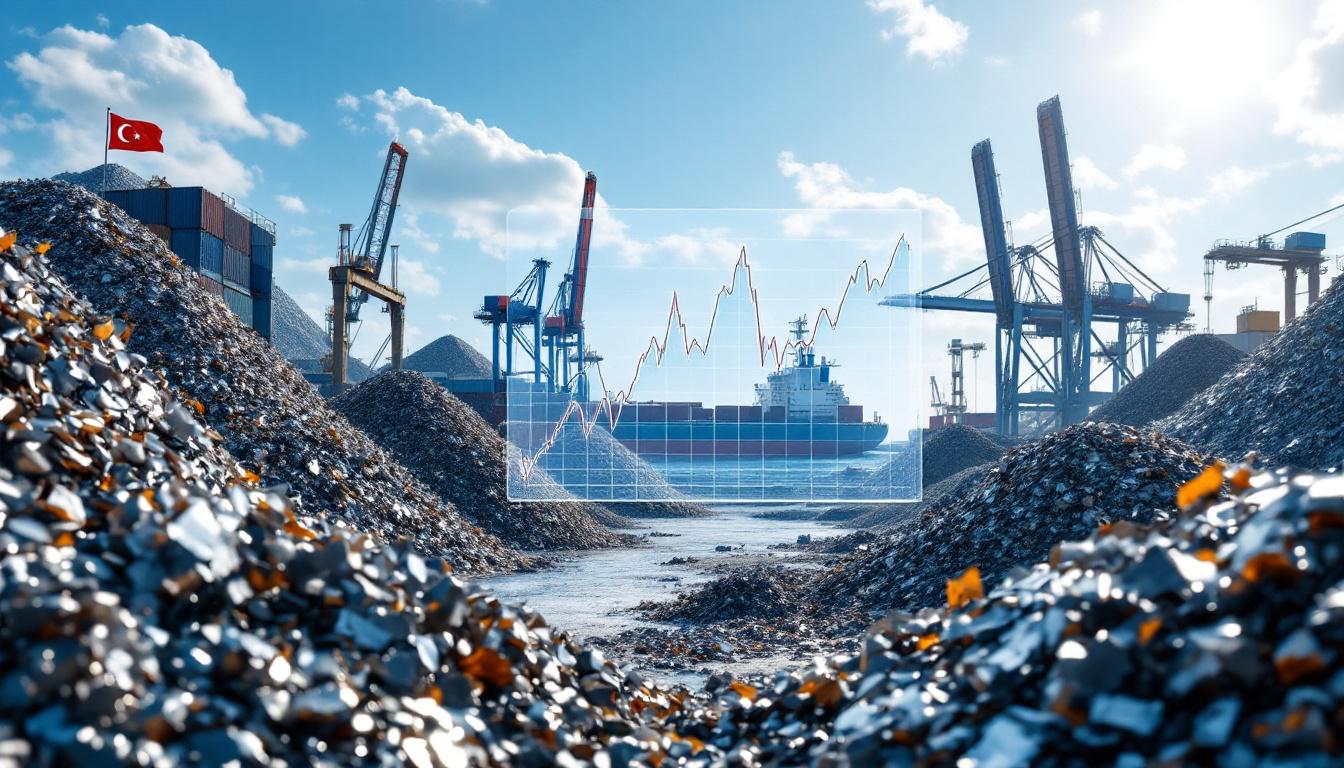What Drove the Increase in Pr-Nd Oxide Production in June 2025?
The rare earth market witnessed a notable shift in June 2025, with Pr-Nd oxide production increasing by 2.6% month-on-month across China. This growth wasn't evenly distributed, however, with Jiangxi and Shandong provinces emerging as the primary drivers of this production surge. These regional variations highlight the increasingly localized nature of rare earth production dynamics in the post-2024 market environment.
Regional Production Growth Patterns
Jiangxi province, traditionally a powerhouse in China's rare earth industry, maintained its leadership position with production growth exceeding the national average. The province's established separation facilities and technological infrastructure allowed producers to respond quickly to improved market conditions. Similarly, Shandong province demonstrated remarkable production resilience, leveraging its developing rare earth industrial base.
Several factors contributed to these regional variations:
- Geographic advantages: Proximity to recycling collection networks in eastern China
- Technological capacity: More advanced separation facilities in certain provinces
- Regulatory environments: Varying levels of environmental enforcement
- Infrastructure development: Better transportation and processing facilities
While some regions showed impressive growth, others faced more significant challenges adapting to the changing market landscape, creating a more fragmented national production picture than seen in previous years.
Scrap Recycling's Significant Contribution
The most remarkable aspect of June's production increase wasn't from traditional mining but rather the substantial growth in the recycling sector. According to Shanghai Metal Market (SMM) analysis, "The rise in Pr-Nd oxide production was not solely dependent on raw ore separation but was more significantly attributed to a notable increase in output from scrap recycling."
This recycling surge was driven by several interconnected factors:
- Favorable price dynamics: Scrap prices reached levels that incentivized collection
- Improved processing technology: Better recovery rates from end-of-life products
- Supply chain maturation: More efficient collection networks for rare earth-containing waste
- Market psychology: Suppliers showed increased willingness to sell into the rising market
The recycling market demonstrated remarkable price sensitivity, with collection volumes responding rapidly to even small price improvements. This created what industry observers describe as a "virtuous cycle" – as more material entered the recycling stream, processing efficiency improved, further incentivizing collection.
As one recycling facility operator noted in the SMM report: "The positive market atmosphere drove up the recycling volume of scrap increased and orders from top-tier enterprises improved, showing a corresponding growth trend that exceeded our projections for the quarter."
How Did Environmental Regulations Impact Raw Ore Production?
While the recycling sector flourished in June 2025, traditional mining and separation facilities faced increasing regulatory scrutiny, creating a notable divergence in raw material sourcing patterns.
Environmental Protection Measures and Their Effects
China's ongoing commitment to environmental improvement manifested in intensified inspection protocols across key rare earth mining regions. These inspections specifically targeted separation plants, which historically have generated significant pollution concerns including acidic wastewater and radioactive tailings.
The regulatory impact varied significantly by region:
- Some facilities faced temporary production suspensions
- Others operated under capacity constraints during inspection periods
- Newer facilities with advanced environmental controls faced fewer restrictions
- Smaller operations without capital for upgrades experienced disproportionate impacts
As SMM reported: "Strengthened environmental protection inspections in a certain region affected the production activities of local separation plants to a certain extent." This resulted in a measurable, though modest, decrease in raw ore-based production during the month.
The inspection regime focused particularly on:
- Wastewater discharge quality
- Tailings management practices
- Air emission compliance
- Energy efficiency metrics
- Regulatory documentation and reporting
While these measures created short-term production constraints, they reflect China's longer-term strategy of improving environmental performance across the rare earth value chain.
Balancing Production Sources
The decrease in raw ore production could have created supply constraints in previous years. However, June 2025 demonstrated the industry's growing adaptability as recycling volumes more than compensated for the reduction in primary production.
This balance shift represents a significant structural change in China's rare earth industry, with several important implications:
- Reduced environmental footprint: Recycling typically generates fewer pollutants than primary extraction
- Resource conservation: Extended utilization of existing materials reduces pressure on reserves
- Supply stability: Diversified sourcing improves resilience against regulatory changes
- Value chain evolution: Growth of specialized recycling enterprises
The industry's ability to maintain overall production growth despite raw ore constraints signals an important inflection point in the maturation of China's rare earth industry. As environmental regulations become increasingly stringent, this flexibility in sourcing will likely become even more valuable.
What Patterns Emerged in the Pr-Nd Alloy Market?
Downstream from oxide production, the Pr-Nd alloy sector showed its own distinctive patterns in June 2025, with growth concentrated among industry leaders rather than distributed across the sector.
Top-Tier Enterprise Performance
According to SMM analysis, "The growth in Pr-Nd alloy production was mainly due to significant increases in orders received by individual top-tier enterprises." This concentration of demand among market leaders signals an important shift in purchasing patterns from downstream industries.
Several factors appear to be driving this selective growth:
- Quality consistency: Top-tier producers maintain stricter quality control
- Supply reliability: Larger operations offer more predictable delivery schedules
- Technical support: Leading producers provide better application engineering
- Scale efficiency: Larger batch processing improves cost structures
The growth was particularly evident in alloys destined for high-performance applications such as EV traction motors and industrial automation systems, where performance specifications are becoming increasingly stringent and where supply chain reliability is paramount.
Market Concentration Dynamics
This uneven distribution of orders appears to be accelerating a broader consolidation trend within the industry. While the top-tier enterprises expanded production activities in response to improved demand, many smaller producers continued to struggle with insufficient order volumes.
The market concentration pattern manifested in several observable ways:
- Order size differentiation: Larger average orders flowing to top-tier producers
- Capacity utilization gaps: Higher utilization rates at industry leaders
- Price premium sustainability: Top producers maintaining better margins
- Investment disparities: Continued capital improvements at leading facilities
This trend suggests the rare earth alloy sector may be following the consolidation pattern seen in other Chinese industrial sectors, where initial fragmentation gives way to concentration among a smaller number of larger, more efficient producers. As one industry observer noted in the SMM report: "This growth was not a widespread phenomenon within the industry but was driven by the outstanding performance of specific enterprises."
The selective nature of the demand recovery has important implications for industry structure and competitive dynamics in the months ahead.
What Are the Supply-Demand Implications for the Rare Earth Market?
The 2.6% month-on-month increase in Pr-Nd oxide production, coupled with the selective growth in alloy demand, provides important signals about the overall supply-demand balance in the rare earth market.
Production Capacity Utilization
June's production increase indicates improving capacity utilization across the industry, albeit with significant variation between facilities. This growth is particularly notable given the environmental constraints on raw ore processing, demonstrating the sector's ability to adapt through alternative sourcing channels.
Several capacity dynamics were evident:
- Recycling facilities: Operating at higher utilization rates than previous months
- Modern separation plants: Maintaining high utilization despite inspections
- Older separation facilities: Experiencing more significant constraints
- Regional variations: Higher utilization in Jiangxi and Shandong provinces
This uneven capacity utilization pattern reflects both regulatory pressures and market responses, with facilities able to process recycled material gaining advantage over those dependent solely on raw ore inputs.
The industry's ability to increase production despite these constraints suggests sufficient capacity exists to meet current demand levels, though with changing distribution across facility types.
Demand Indicators and Market Sentiment
The selective improvement in orders at top-tier enterprises provides a nuanced view of demand recovery. Rather than broad-based growth, the market appears to be experiencing what economists term a "quality-focused recovery" where reliability and consistency command premium positioning.
Key demand indicators included:
- Order patterns: Larger volume commitments from established customers
- Price stability: Improved pricing in certain product categories
- Inventory management: More strategic purchasing rather than spot buying
- Forward contracting: Increased willingness for longer-term commitments
These signals suggest selective rather than broad-based demand improvement, with downstream users prioritizing supply chain security over lowest possible cost. As the SMM analysis noted, this improved demand primarily benefited established industry leaders with proven track records.
The willingness of suppliers to increase sales volumes into the market indicates positive price expectations, suggesting market participants anticipate continued demand improvement in coming months.
How Is the Rare Earth Recycling Sector Evolving?
The substantial contribution of recycling to June's production growth highlights the sector's increasing importance within the rare earth value chain, representing a significant evolution in China's approach to resource management.
Recycling Economics and Incentives
June 2025 demonstrated the growing economic viability of rare earth recycling, with price trends creating favorable conditions for collection and processing. The recycling sector showed remarkable responsiveness to these market signals, with volumes increasing significantly as prices improved.
Several economic factors contributed to this growth:
- Price spreads: Widening margins between input costs and output values
- Collection efficiency: Improving yields from established collection networks
- Processing technology: Better recovery rates reducing per-unit costs
- Scale economics: Higher volumes supporting more efficient operations
The recycling sector demonstrated greater price elasticity than primary production, with volumes responding more quickly to market signals. This responsiveness creates both opportunities and challenges for market stability, potentially introducing more volatility in supply response.
The economic incentives driving recycling growth represent a significant shift from earlier periods when recycling was primarily driven by environmental considerations rather than profit potential.
Sustainability Implications
Beyond economics, the growth in recycling volumes represents an important sustainability transformation for China's rare earth industry. Recycled materials typically require 85-95% less energy than primary production and generate significantly lower environmental impacts across multiple categories.
The sustainability benefits include:
- Reduced mining intensity: Less land disturbance and habitat impact
- Lower water consumption: Recycling typically uses substantially less water
- Decreased chemical usage: Fewer processing reagents required
- Smaller carbon footprint: Lower energy inputs throughout the process
- Waste reduction: Diversion of end-of-life products from landfills
These environmental advantages align with China's broader sustainability objectives while also providing supply chain benefits. As environmental regulations continue to tighten on primary production, the relative advantages of recycling are likely to increase further.
The growth in recycling also helps mitigate supply risks associated with primary production constraints, creating a more resilient overall supply picture. This evolution toward a more circular economy for rare earths represents one of the most significant structural changes in the mining industry evolution in recent years.
FAQ: Rare Earth Market Trends
What factors influenced the increase in Pr-Nd oxide production in June 2025?
The 2.6% month-on-month increase in Pr-Nd oxide production was driven by multiple factors working in concert. While Jiangxi and Shandong provinces showed the most significant regional growth, the primary driver was the substantial increase in recycling volumes rather than expansion of raw ore processing. Favorable price trends encouraged suppliers to sell into the market, creating positive momentum that further stimulated collection and processing activities. Despite environmental constraints on raw ore separation in some regions, the flexibility of the recycling supply chain enabled overall production growth.
How did environmental regulations affect the rare earth market in June?
Environmental protection inspections in certain regions constrained the production activities of local separation plants, causing a measurable though modest decrease in raw ore-based production. However, the industry demonstrated remarkable adaptability by increasing recycling volumes to more than offset this decrease. This shift represents an important evolution in China's rare earth industry, showing increased resilience against regulatory pressures through supply diversification. The longer-term impact of these environmental measures will likely accelerate the transition toward more sustainable production methods.
Why did only top-tier enterprises see improved orders for Pr-Nd alloy?
The concentration of order growth among select top-tier enterprises reflects an important shift in purchasing priorities among downstream users. Rather than seeking lowest possible costs, buyers increasingly prioritize quality consistency, supply reliability, and technical support capabilities – areas where established leaders typically excel. This selective demand pattern is accelerating market consolidation, potentially leading to an industry structure dominated by fewer, larger producers. The pattern also reflects growing quality requirements in end-use applications such as electric vehicles and advanced manufacturing.
What does the increase in recycling volume indicate about the rare earth market?
The significant increase in recycling volume signals several important developments in the rare earth market. First, it demonstrates the growing economic viability of recycling as a mainstream supply source rather than a niche activity. Second, it highlights the market's increasing adaptability, with recycling providing flexibility when primary production faces constraints. Third, it represents progress toward a more circular economy model for rare earths, reducing environmental impacts and resource depletion. Finally, the price sensitivity of recycling volumes suggests this sector will play an increasingly important role in balancing supply and demand fluctuations in the future.
Further Exploration:
Readers interested in learning more about trends in the rare earth market can also explore related educational content about critical minerals energy transition and battery recycling breakthrough technologies, which offer regular analysis and insights on developments in the critical minerals sector. Furthermore, understanding modern waste management solutions is essential for comprehending the full scope of the recycling industry's evolution.
Want to Spot the Next Major Mineral Discovery?
Discovery Alert's proprietary Discovery IQ model provides real-time notifications when significant mineral discoveries are announced on the ASX, giving investors a crucial edge in the market. Explore how historic discoveries have generated exceptional returns by visiting our dedicated discoveries page and position yourself to capitalise on the next major find.




